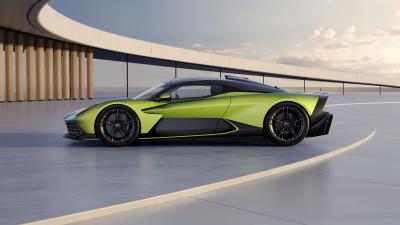That the Aston Martin Valkyrie exists as a road-legal car at all is remarkable, but it’s not perfect. You have to fold yourself in half to get inside and wear ear defenders when you’re driving it, and its highly-strung drivetrain has had its fair share of well-documented issues. Now, though, we’ve got full details on its offspring, the Aston Martin Valhalla, and it looks set to offer 99 per cent of the Valkyrie’s performance without those compromises.
We’ve known the Valhalla was coming for a while – a concept appeared way back in 2019, and we got a look at something closer to the final article in 2021. It’s even cameo’d in a Bond film, seemingly a rite of passage for an Aston these days. This is the car people will start taking delivery of next year, though, with its final specs confirmed – and they’re quite impressive.
The Valhalla is Aston’s first plug-in hybrid, with the noisy bit being the 4.0-litre Mercedes-AMG-sourced twin-turbo V8 that underpins much of the rest of Aston’s range. Here, though, it’s got new cams, exhaust manifolds and pistons, bigger compression wheels in the turbos, and a flat-plane crankshaft. On its own, it makes 817bhp, all of which goes to the rear wheels.
It’s backed up by three electric motors. A pair of radial flux motors power the front axle, and feature their own electric drive unit that allows them to rapidly juggle torque from wheel to wheel. A third motor sits in the gearbox – an all-new eight-speed dual-clutch system – and gives the engine a helping hand in powering the back wheels.
With everything running at peak power, the four-wheel drive Valhalla churns out 1064bhp – really not a lot less than the 1140bhp Valkyrie. The performance figures run the big boy fairly close, too: a 217mph top speed for the Valhalla plays the Valkyrie’s 220mph, and Aston predicts a 0-62mph sprint of 2.5 seconds – level pegging with the Valk.
The Valhalla is built around a carbon fibre tub, with aluminium subframes bolted to each end to hang all the oily bits off. It’s then clothed in full carbon-fibre panels. Dry weight is quoted at 1655kg.
The suspension – tricksy inboard pushrods up front, and a five-arm multi-link setup at the rear – features the same Bilstein DTX adaptive dampers that have helped transform the Vantage and DB12, offering multiple levels of aggression including a new Race mode.
Carbon-ceramic discs – 410mm with six-piston callipers on the front wheels, and 390mm with four-pots on the rears – help bring everything to a stop, with a brake-by-wire system in place of a traditional mechanical link. In Race mode, they’re helped along by active surfaces on the front and rear acting as airbrakes, and the Valhalla also uses regen braking to further augment stopping power and top up the battery.
Like all modern supercars, there’s much aero at play. At speed, those same surfaces that pop up under braking flatten out to make the Valhalla as slippery as possible, while underneath, there’s a big empty space helping create a ground effect and suck it to the floor. An active front wing helps channel air through underbody strakes and into this area. Aston says that from 149mph onwards, the Valhalla will make a consistent 600kg of downforce.
An intricate system of vents and ducts on the outside keep everything cool while channelling more air to the aero bits, and the engine’s fed by a big roof-mounted airbox that’s inevitably described as ‘F1-inspired’. Like the Porsche 918 and McLaren 600LT, the Valhalla gets a pair of exhausts that exit straight upwards out of the rear deck, purely because it looks cool. A further two pipes exit in the traditional fashion underneath. If good taste isn’t your thing, you can have the entire body left in unpainted carbon.
The interior isn’t exactly plush, but it’s a world away from the cramped, uber-spartan quarters offered by the Valkyrie. Much of the fittings come from the latest breed of lesser Aston, which is no bad thing. The instrument screen now provides plenty of info on what the electric components of the drivetrain are up to, while you’ll get a nice horizontal rev counter and some shift lights when you flip it into Race mode. Naturally, Aston’s bespoke Q division will do pretty much whatever you want with both the exterior paint and interior trim.
So are the people who dropped goodness knows what on a Valkyrie about to have egg on their faces? Probably not. It may be almost as rapid and seemingly far more usable, but there are a few things the Valhalla doesn’t have, namely that shrieking Cosworth V12 and Adrian Newey’s name attached (although with him now at Aston, who’s to say things won’t come full circle?).
It’ll also be common as muck – while only 235 Valkyrie road cars were built, there’ll be a whole 999 Valhallas. The first of these will go into production in Q2 next year, with the first deliveries set for the second half of the year.
Read the full article here



